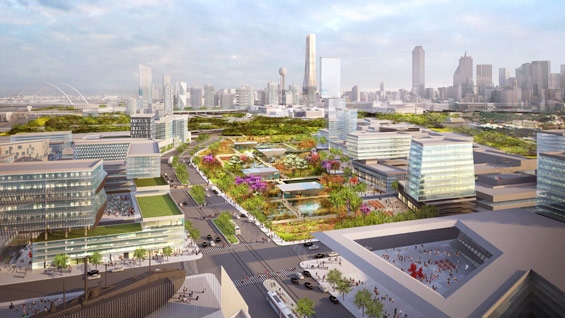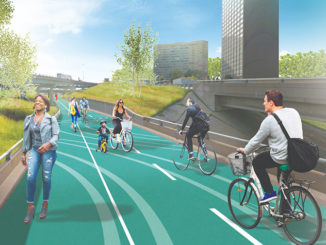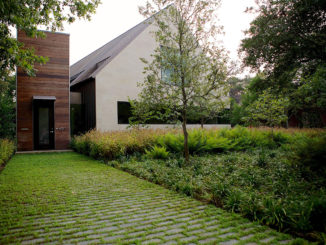Dallas CityDesign has announced the results of the Connected City Design Challenge. Stoss + SHoP‘s proposal, Hyper Density Hyper Landscape, has been uniquely recognized as the preferred proposal among the Professional Stream that included finalists Ricardo Bofill and OMA+AMO. A clear and pragmatic approach offers innovative solutions to Dallas’s urban challenges and sets the stage for transformation that will reunite Downtown Dallas and the Trinity River.
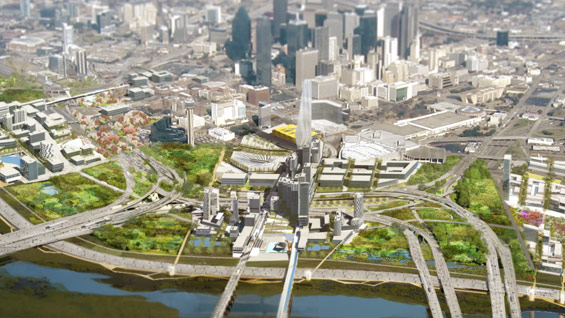
DISTINCT NEIGHBORHOODS
Stoss + SHoP‘s proposal connects the city and its river through an alternating pattern of “grid-green” development. The proposal identifies 176 acres to be developed as three distinct neighborhoods, deployed across 489 acres in a pattern of alternating bands of lush landscape and high density urban development. Each of the three new neighborhoods offers a unique identity, continuing the city’s longstanding development of great neighborhoods.
In the north, DeCCo (Design Crosses Commerce) is a vibrant mixed-use neighborhood that connects downtown with the emerging design district. Residential development is paired with commercial and light industry, drawing the city’s emerging tech and arts sectors. Along the Houston and Jefferson viaducts, The Viaduct extends the central business district towards the river and links Union Square to a new high-speed rail station, a signature office tower, a commercial retail center, a central plaza, a new tech campus, Reunion Tower, and the convention center. Riverfront South bridges the rail corridor to connect Dallas’s South side neighborhood to the Trinity, creating a southern anchor for Riverfront Boulevard with attractive housing, water and music gardens, and two signature institutions.
URBAN FORESTS
The Connected City Jury has recognized Hyper Landscape as an innovative approach to activating public land as entrepreneurial urban forests and farms. The proposal extends the natural systems of the Trinity River towards Dallas’s downtown, providing forests for people. Ecologically diverse and programmatically rich, these playful, active forests weave between the highways and interchanges with a new walk that connects Dealey Plaza with the waterfront, offering lush gardens, cafes, and trails along the way. The forests clean the air and water and provide a new habitat.
TRANSFORMING THE OLD RIVE
The heart of these new neighborhoods and landscapes is a revived and revitalized Old River, transformed from lonely flood basins into a beautiful chain of parks and water gardens that reconnect people with the river that was so important to Dallas’s history. The proposal is organized around a productive water system that reimagines life along the Old River, improving its quality and creating new urban amenities, including wetlands, gardens, and an urban beach. It re-works the water systems that move through the current “sumps,” holding more water in place; creating new urban amenities; improving its quality; and reducing overall volumes that enter the levee at flood stage. Storm-water runoff serves as irrigation to the new urban forests.
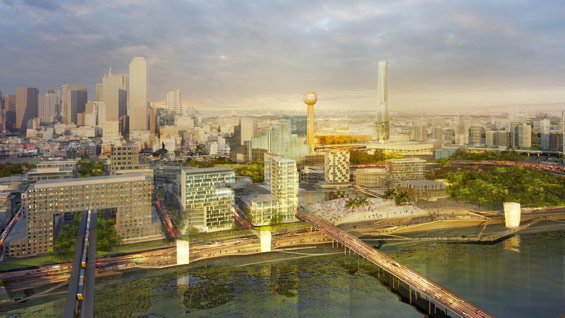
PUBLIC REALM
New public amenities at all scales offer new opportunities to experience the river. Water gardens with lush islands and floating cafes; water amphitheaters, playgrounds, and wet forests; floodable sport courts; and new wetland habitats all create new life from Dallas’s ancestral source. A signature urban beach nestles into the DeCCo district and overlooks the river and a new Pump House Amphitheater provides a new outdoor venue and connects the central business district to the waterfront.
ILLUMINATE THE RIVER
The vision for Dallas is one of many decades, but initiatives and projects that engage the public and disrupt perception now can make way for change. Stoss + SHoP propose to illuminate the river through an artist’s installation, directing Dallas’s attention back to the contours of the river. Tree nurseries and urban gardens can slowly build stock in the future, while providing visual improvements to the city today. With small, key investments in new spaces and new programs, the Trinity River can quickly regain the attention of the city and begin to reinvent itself as a public space.
TRANSPORTATION
The proposal is supported by a strategy for connecting DeCCo, The Viaduct, and Riverfront South through well-designed streets and a robust transportation network. A new light rail and pedestrian promenade intensify the growing energy and vibrancy in the heart of Dallas, where people can live, work, and play in a revitalized, connected city. New streets, sidewalks, bike routes, and streetcars will connect the new neighborhoods with each other and with downtown. Along Riverfront, newly designed as a “complete street,” the ride from the Design District to New Riverfront South will be a rich tapestry of urban environments, natural zones, and gathering spaces.

